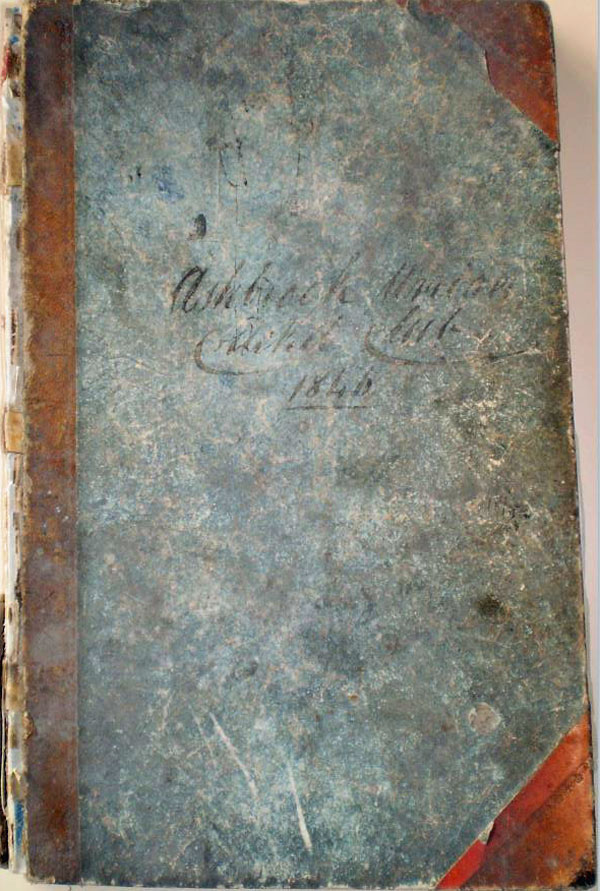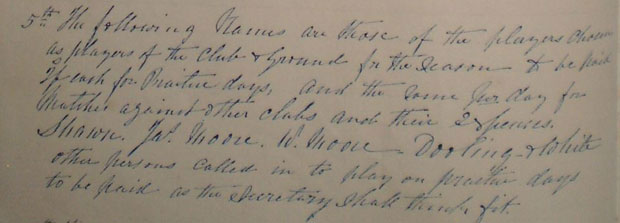In 1846, in Durrow, Co. Laois, the Ashbrook Union Cricket Club played on the local estate at Castle Durrow, which was at the centre of this small town. The estate owner, Viscount Ashbrook, family name Flower, was president of the club. He was integral to the growth of the club. He also opened the batting on the occasions when he played for his team, whether it was in practice matches or in fixtures against a visiting eleven.
In January 2012 I received a call from Philip Sheppard, Sheppard's Auctioneers, Durrow, in relation to a cricket manuscript which was due to come up for auction. This unique sporting item was apparently found in a skip and was later sold at a car boot sale. Philip asked me to look through the scorebook and see if I could 'make something of it' or find out any significant information within. He told me to take it home and have a good read through of it and return it when finished.

So for little under a week I had a unique piece of, not only Irish cricketing history, but a very important part of Irish sporting history in my home. This was Holy Grail time as far as I was concerned.
When the scorebook came up for auction, the Stokes family, owners of Castle Durrow and Roland Bradley, later to become President of Cricket Leinster and a Trustee of Laois CC, were determined that this important piece of Laois and Leinster cricket heritage would remain in its home town. Thankfully, they were successful in this respect.
Following restoration, the scorebook is now preserved for future generations in Castle Durrow. If ever there was a case of 'cricket coming home', this was it. Crucially, the Ashbrook Union scorebook is a very early and important document relating to club sport in existence in Ireland.
Starting in 1846 it records the match details for all games played by the club, whether inter-club games or practice games between club members. It covers the years 1846 to 1848 and each year starts with the names of the club president, vice-president, secretary and a list of club members. It gives a unique insight into sport and society at the height of the Famine period. It also shows how some men earned a very nice income at a time when there was severe poverty, destitution and death throughout much of Ireland.

From 25 April 1846 to September 1846, the club played 26 matches, of which only four were not inter-club fixtures. These were home and away matches against Danesfort CC, Co. Kilkenny and Carlow CC. Much more importantly, the details for 1847 reveal how carefully organised the club was at the time.
The club was structured with a defined set of rules and regulations. It clearly shows that a fledgling sporting economy had begun, even at this early date. Some of the details from the 'Rules and Regulations 1847' are as follows:
Rule #1 noted that each member was to pay £1 per annum subscription.
Rule #3: All members playing in practice matches to pay one shilling for every match they are on the losing side to go to the ground fund of the club. A luncheon to be provided on every practice day for members of cold meat for which each member attending on those days to pay one shilling and six pence.
Rule #4: All members playing in matches against other clubs to pay five shillings for each match in which they play in addition to their annual subscription.
Rule # 5: The following names are those of the players chosen as players of the club and ground for the season to be paid 2/- each for practice days and the same per day for matches against other clubs and their expenses. Shawn, Jas. Moore, W. Moore, Dooling and White. Other persons called in to play on practice days to be paid as the Secretary shall think fit.

From 22 May 1847 and 18 September 1847 the club played 21 matches, of which nine were against external teams. These external teams were: Kilkenny CC; Huntingdon CC Laois; Carlow CC; Templemore CC Tipperary; a Wexford and Carlow joint eleven; Castlecomer CC of Kilkenny and a Phoenix and Garrison selection Dublin. In the first two matches against Kilkenny CC and Huntingdon CC the club retained the name of Ashbrook Union CC. However, for all other games it took the name of Durrow CC.
For the two seasons of 1847 and 1848 there were 44 matches played by the club, of which 31 were internal games and 13 were against other teams. One man, who was only ever referred to by his surname, Shawn played in all 44 matches. He was one of the five men named as 'players of the club'. The other named men played the following number of matches in 1847 and 1848. W. Moore 42 matches; James Moore 32 matches; White 38 matches and Dooling 22 matches;
Each man was paid two shillings per match, meaning the club, over the two years, paid out a minimum of £17 16s in match fees. This is because there were also a number of Gentlemen v Players matches, so if the aforementioned five men were paid to play, once could infer that the other players would receive some form of pro-rate payment.
Some other additional features of the club indicate that play was likely on any day of the week except Sunday. It is likely that some, if not all, of the men who played on the Ashbrook Union CC team were also employed on the estate. A man by the name of Kearney played for the club. Miles Kearney, a stucco plasterer by trade lived in the town and the principle residence in the town which would have required such a skilled tradesman was Castle Durrow.
One of the gentlemen members of the club was Robert White, Aghaboe, Ballacolla, Co. Laois. Born 21 February 1827 he received a commission 15 October 1847, and served in the Eastern Campaign of 1854 with the 17th Lancers, including Bulganak, and the battles of Alma and Balaklava, and the Siege of Sebastapol. For his services in the Crimea he received the medal with three clasps, a brevet majority, the 5th class of Medijide and the Turkish medal.
In 1857, Captain White proceeded with his regiment to India and served throughout the campaign in central India in 1858-59. He reached full general's rank in 1890, having been Colonel of the 21st Empress of India's Lancers since March 1886. He died at Aghaboe Grange on 15 September 1902, aged 75 years. One of those represented at his funeral, from his days with Ashbrook Union CC was Hon. R. Flower, a descendant of the first president of the club.
From the details of the scorebook and the payment of players, one could infer that similar instances took place with other teams around Ireland at that time. This was not unique to Ireland. It followed 18th c. trends in England, where skilful cricket players were retained as employees on estates, whether it was as a gardener or a groom.
The Ashbrook Union CC scorebook is a fascinating manuscript of Irish cricket history and it sheds light into the embryonic development of cricket in Ireland. That it has survived the vagaries of time is all the more important, as it is likely that many other similar documents perished in the wanton destruction of landed estates throughout the island.
All are welcome to view the manuscript at Castle Durrow when it safe to do so and travel is permitted.
